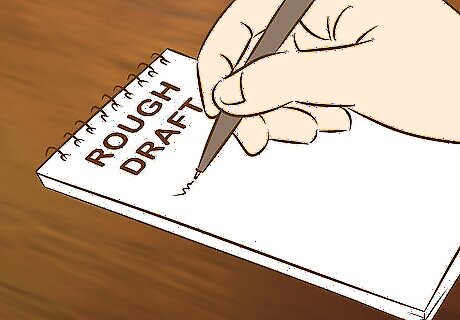
views
Preparing to Write the Review

Understand the purpose of a play review. A play review is a subjective and educated response to a piece of theater. The reviewer should have a strong background in theatre so their opinion is informed and credible. Though this is not a requirement for writing a good play review. The review should also give potential audience members a sense of the play. It should let readers know if spending their hard-earned money on a ticket to the production will be money well spent. Noting that you thought the play was “good” or “bad” will not create a strong play review. Instead, you should be specific in your critique and have a thoughtful analysis of the production. Your opinion on the play should be supported by a discussion of the production elements and how they worked together as a whole. The review should also describe the situation or plot of the play without giving too information to the reader. Avoid spoiling any plot twists or turns for potential audience members in your review.

Look at the traditional structure of a play review. The standard play review contains five paragraphs. There are other approaches you can use, such as comparing two plays in one review or writing longer reviews for one play. But traditionally, a play review will analyze several elements of the production in five paragraphs, including: Paragraph 1: Your introductory paragraph should describe what you saw on stage. You should also give context for the play, such as the playwright or composer of the play and where the play is being staged. Paragraph 2: Briefly summarize the plot of the play. Paragraph 3: Discuss the acting and directing. React to the performers playing the characters in the play. Paragraph 4: Describe the design elements of the production, such as the lighting, sound, costumes, make up, and set and props. Paragraph 5: React to the play as a whole. Would you recommend the play to potential audience members? You can also include a recommendation, like a star rating or a thumbs up/thumbs down.

Read and analyze review examples. Do a google search of local plays in your city that have reviews online. Pick up a newspaper and check the Arts & Culture section for play reviews. You can also access example reviews online. Read the review(s) and ask yourself: How does the reviewer structure her review? Does the review follow the traditional structure, with an introduction in paragraph 1, a plot summary in paragraph 2, a discussion of acting and directing in paragraph 3, a discussion of the production elements in paragraph 4, and an overall critique in paragraph 5? Compare two reviews of the same play. How do the reviews compare and contrast? Are they structured differently or have different critiques of the play? Is the reviewer overly critical of the play? Does their analysis seem well supported by scenes in the play, or a discussion of design elements of the play? How does the reviewer wrap up the review? Is there a recommendation at the end of the article, such as a star rating or a thumbs up/thumbs down?

Read the play you are going to review, if possible. If you are reviewing a popular play, like “Hamlet” or “The Little Shop of Horrors”, you should be able to find a hard copy of the play. Newer or more obscure plays may be harder to find in hard copy. Reading the play will help you get familiar with the subject matter and how it appears on the page before you see the production live. Note the stage directions, the setting notes, and the line breaks or pauses in the dialogue. Pick out any problematic points in the play that you might want to watch for during the production. For example, if you’re going to see Shakespeare’s “Hamlet”, you may make a note of ways the director might stage the pivotal Ophelia drowning scene. Or if you are going to a musical like “The Little Shop of Horrors”, you might note how the director will transition from the song numbers to the dialogue in the production. Your instructor may also ask you to pay particular attention to certain elements, like the lighting or the costumes, so make sure you are prepared to recognize them.

Get a sense of the context of the production. You don’t want to do too much research around the production as it may influence your viewing experience. But you should have a sense of the context of the production; which theater company is putting it on, who is directing the play, and what liberties, if any, have they taken with the original content. For example, you may be seeing a version of “Hamlet” that is set in contemporary times and integrates technology in the production. Or you may be seeing a production of “The Little Shop of Horrors” that is set in a record store, rather than a theater. This setting change will change the context of the play, and you should then note how the setting choice is used in the production in your review.
Writing the Review

Look at the play’s program. Try to get to the theater or production setting 15 minutes before show time. Flip through the play’s program. Look for a director’s note and the cast biographies. You should also check if there are any understudy replacements for the production, especially if the show is promoting itself based on the popularity of a certain performer. Note if there are any write ups in the program about a directorial choice, like setting “Hamlet” in contemporary times. There may also be notes on the lighting or the sound design. Don't: judge the premise of the play based on your personal tastes. Your readers can decide for themselves whether it appeals to them.Do: consider the goals behind production decisions and be prepared to evaluate whether the play achieves them.

Take notes during the show. Its important to write down any striking details during the production. But try not to bury your head in your notebook during the entire production. You may miss certain details or a key moment. Use the intermission, which usually happens between acts in a play, to take more detailed notes. Consider: The set design. Look at design elements like lighting, sound, costumes, makeup, and props. The acting and directing of the production. If a certain casting choice seems important, write it down. If a line of dialogue strikes you, make a note of it. Look at the way the actors say their dialogue and move around the stage. Are they serious, comedic, formal? Do they use modern slang or speech, even though the play was originally set in an older time period? Any “special effects” used, such as special lighting, sound or technology. Note if the production also uses audience participation to keep the audience engaged. Right after the performance, you should jot down any concluding notes, including your initial impressions of the production and how successful or unsuccessful you think the production was.

Write a rough draft of the review right after you have seen the production. The longer you wait, the less you’ll remember your experience of the play. Remember your role as a critic is to describe, analyze, and judge. In your review, you will need to: Describe what you saw in detail and make the reader see what you see. Be specific and thorough in your descriptions. Analyze what you think the director or designer was trying to achieve. Why do you think they designed the movements, lights, sounds effects, and costumes a certain way? What do you think they were trying to make the audience feel or think? Judge how effective the play was as a whole. Don’t be afraid to give an honest opinion of the production but be sure you can back up your critique in the body of your review (paragraphs 2-4). Don't: make your personal opinion the main feature.Do: state your opinion honestly, grounded in specific points.

Create a strong hook or line to open the review. You may start with a summary of the play if it is a re-staging of a production your audience is familiar with. For example, in this review of “The Little Shop of Horrors”, the reviewer begins with the line: “This Fringe classic pops up most years, with songs such as ‘Somewhere That’s Green’ and ‘Don’t Feed The Plants’ bringing the house down.” This opening line works because it allows the reader to dive right in. In one line, the reviewer has introduced the play, noted the play is a “classic” and told the reader it is a popular musical. You can also start with a hook that challenges the audience’s expectations of a familiar production. For example, in this review of “The Little Shop of Horrors”, the reviewer begins with the line: “Not many musicals will issue you with a sing-a-long book with the lyrics to chorus numbers so you can join in, but this interactive production of The Little Shop of Horrors has a few surprises in store.” This hook works because it tells you that the play is a unique take on a classic production and is interactive. Don't: write an exciting hook that has nothing to do with the rest of your review.Do: take risks with bold statements or an unusual opening.

Answer who, what, where, and when in paragraph 1. The introductory paragraph should cover basic information about the play, including: The full title of the play. Where did you see the show? Name the theater or setting where you saw the play. When did you see the show? Maybe it was opening night, or the last week of the show’s run. Be specific about the exact date you saw the show. Who wrote the show? Who directed the show? Name the playwright, the director, and the name of the production company. If the show is a restaging of an existing play, such as “The Little Shop of Horrors” or “Hamlet”, you should note this in your introduction. If the show is a new or original production, you should also note this.

Discuss the plot in paragraph 2. Briefly summarize the plot of the play, including the setting, the main characters, and the story arc of the characters. Try to keep the summary to one or two lines. You should give the reader just enough information to get a general sense of the play’s plot. For example, you may summarize the plot of “The Little Shop of Horrors” with: “The Little Shop of Horrors is such an entertaining musical because of its hilarious plot involving a plant which grows to an incredible size and the romantic love story of Seymour and Audrey.”

Talk about the acting and directing in paragraph 3. React to the performers playing the characters in the play. Use their real names and their character names. Write about the acting based on questions such as: Were the performers believable? Did their relationships or chemistry with the other characters seem natural and appropriate? Did the performers stay in character throughout the play? Did the performers have a vocal quality (volume and articulation) that fit the context of the play? Did their body movements and gestures stay true to the character they were playing? Were the performers engaging and interesting to watch? If so, why did you find them engaging? For example, in your review of “The Little Shop of Horrors” you may note: “The main credits of this production go to the lead roles Cath Snowball (as Audrey) and Chris Rushmere York as Seymour who created a really tangible but very shy and coy chemistry.” Don't: discuss an actor's personal appearance or insult to the point of cruelty.Do: describe misguided or failed performances honestly.

Analyze the design elements of the play in paragraph 4. The design elements are a big part of a production and should be discussed in detail in your review. Focus your analysis on: The set and the props: Did they establish the correct mood for the play? Did they add to the development of the characters, the plot, and the setting? Were they convincing and well-made? Did the blocking on stage make sense? Blocking means how the actors are positioned on stage within the set. Were there any awkward movements by the actors on stage? Did the set help or hinder the performances? The lighting: Did the lights convey a mood that fit with the tone of the play? Did they draw attention to characters or props that seemed important in the play? The costumes and the make up: Did the costumes and the make up of the performers suit the time period of the show? Was there a unique approach to the costumes or the make up that affected the context of the play? The sound: How did the music, if any, contribute to the show’s mood? Were there sound effects used in the show, and if so, how did they add to the production? If you are reviewing a musical, you should note if there was a live orchestra or if the music was pre recorded, and how that affected the tone of the play overall. Try to be as detailed as possible in your discussion of the design elements. For example, in a review of “The Little Shop of Horrors”, you may note: “A quirky directorial decision was to have the props and cast in grey scale. These performers were caked in grey and black make up to contrast the monstrous green plant as it ate people alive, growing bigger and bigger as the play went on.”

React to the play as a whole in paragraph 5. Here is where your final critique should be in the review. Avoid clichéd phrases like “the play was bad” or “the production wasn’t very entertaining.” Instead state your opinion of the performance as a whole, and show why your response to the play is valid and significant. The rest of your review should support your overall judgment of the play. Note if the audience seemed attentive and interested throughout the performance. Also point to any possible adjustments or changes that could have been made to the production to make it stronger or more engaging. For example, you may note: “Though the production was clearly taking some creative risks by having all the performers in greyscale, not bringing in bright green plants for the show-stopping “Something Green” number felt like a missed opportunity to capitalize on this contrast.” Leave your reader with a clear sense of your opinion on the play and with more questions than answers about the play. For example, you may wrap up your review of “The Little Shop of Horrors” with: “This new production takes some creative risks and emphasizes the singing skills of the performers, who manage to pull off this tale of love and a monster plant with passion and conviction.”




















Comments
0 comment